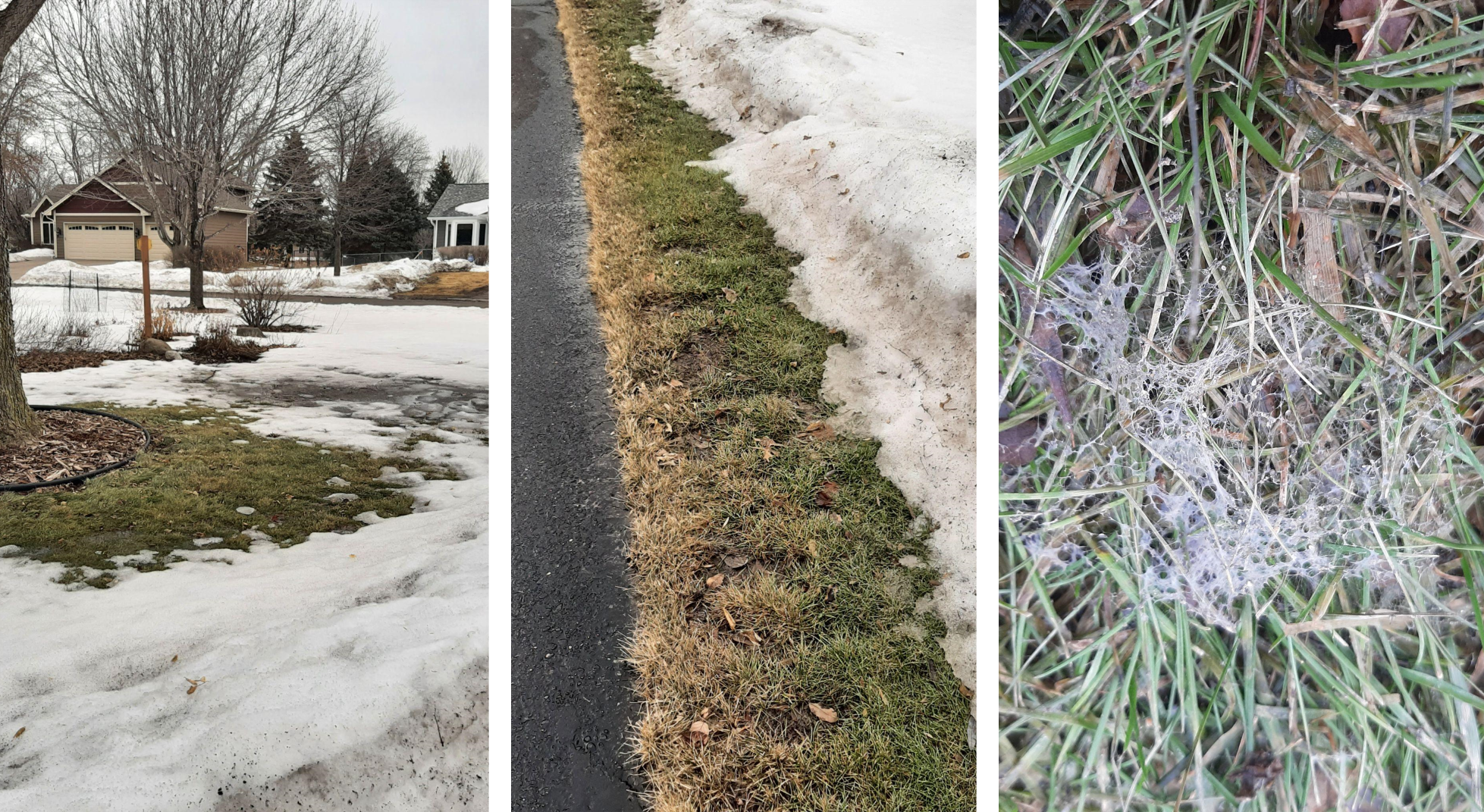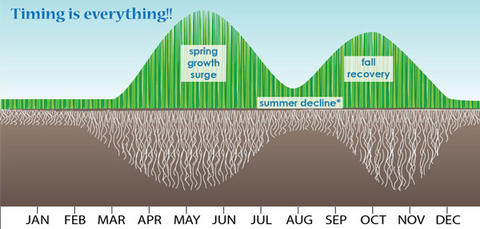Welcome to the latest issue of the Home Lawn Care Newsletter from UMN Turfgrass Science! We will provide up-to-date information to address all your lawn care tasks at the times when you need to know.
Mar 16, 2023: Issue 9
Watch for problems areas in your lawn
Snow cover has been heavy this year. The next month is going to offer us good opportunities to watch for areas in our lawn that might become problematic come spring. What to watch for? Areas in your lawn that open up first as snow melts such as low areas that hold water or freeze, browned areas along driveways where salt may have damaged grass, and spots with snow mold.

- Areas that hold water or ice are places you don't want fine fescues or especially tall fescue. Kentucky bluegrass may be a better grass option.
- Areas that are browned from salt would be good places for fine fescues, especially strong or slender creeping red fescue types. Fine fescues tolerate salt better than Kentucky bluegrass.
- Areas that are matted and straw-brown in color may show mycelium (fungus that looks like spiderwebs) that are typically a sign of snow mold. In most cases, the grass can recover but you may need to be patient. Consider lightly raking the area to clear the dead or rotting turf.
We'll have more detail about how to deal with these in the coming months, but for now, observe where trouble spots are. If you have to replant, some species are better adapted to certain conditions than others.
Check out tools for using less water this year
There is still snow on the ground, but we will still have recovery from last year's drought to consider this spring. There are some new and cool options for monitoring water in the soil, as well as options for watering to check out now before they are in high demand this summer.
For lawns that have irrigation systems, check out the video Green Grass with Less Blue: Smart Controllers from the Metropolitan Council and the UMN Turfgrass team. Being able to automatically run your irrigation according to the amount of soil moisture or amount of rain can mean you don't have to constantly watch the weather forecast and guess how much water your lawn needs. Contact your water utility to see if they offer a rebate for smart irrigation controllers. Irrigation controllers save money on your water bill either way.
For lawns without irrigation systems, options include hose-end timers. Do an online search for "best of" recommendations. A simple version will allow you to water one area for a set period on a given day. Some versions can be set for multiple intervals and frequency. Tools like these can be great options for those who don't have irrigation systems, but need to apply water periodically, such as watering in a new lawn.
Lastly, if you prefer to stay low-tech, consider a manual moisture meter. You simply push the meter into the soil 6 to 8 inches deep, wait about a minute, and you'll know if it's time to water. These are reasonably priced at your local hardware store. See our Irrigation Resources webpage for more information on irrigation.
One other thing to help your lawn this year

Check out the University of Minnesota Lawn Care Calendar. All lawn care activities are more effective when you do them at the right time. Study up on the calendar and watch for our future newsletters for tips that will help you adapt to the current conditions and latest turfgrass research! Are you a new subscriber to this newsletter? You can catch up by reading our previous issues.
Research Highlights
The UMN Turfgrass Science team devotes many research and education efforts to help people be more efficient when using landscape and lawn irrigation water. For example, cities in Minnesota often have watering restrictions during the summer, such as even-odd watering bans or restrictions based on time of day, that residents must follow when watering their lawns and landscapes. But how do residents feel about these restrictions? Are they an effective tool for conserving water? Read about this research and related topics in the articles below.
- Support for lawn watering restrictions in the land of 10,000 lakes by Michael Barnes
- Homeowner perceptions of watering restriction scenarios in the Minneapolis-St. Paul metropolitan area by Michael Barnes, Chengyan Yue and Eric Watkins
- Outdoor water use in the Twin Cities: Am I using too much? A video with Shane Evans and Brian Davis
Events
The UMN Turfgrass Science team will be at:
- Rosemount Home & Business Expo in Rosemount, MN from 9:30 a.m. to 1:30 p.m. on Saturday, March 18, 2023.
- Home Landscaping and Garden Fair in Andover, MN from 8:00 a.m. to 3:15 p.m. on Saturday, April 1, 2023.
- We will be at these events to answer questions on smart irrigation and lawn care as part of our collaboration with the Metropolitan Council.
Turfgrass Extension Educator Jon Trappe will be at Horticulture Day at the Southwest Research and Outreach Center in Lamberton, MN at 11:00 a.m. on Tuesday, March 28, 2023.